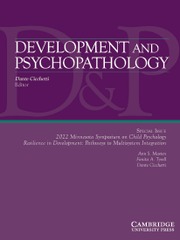Crossref Citations
This article has been cited by the following publications. This list is generated based on data provided by
Crossref.
Moos, Rudolf H.
2002.
2001 INVITED ADDRESS: The Mystery of Human Context and Coping: An Unraveling of Clues.
American Journal of Community Psychology,
Vol. 30,
Issue. 1,
p.
67.
Luthar, Suniya S.
D'Avanzo, Karen
and
Hites, Sarah
2003.
Resilience and Vulnerability.
p.
104.
Grant, Kathryn E.
Compas, Bruce E.
Stuhlmacher, Alice F.
Thurm, Audrey E.
McMahon, Susan D.
and
Halpert, Jane A.
2003.
Stressors and child and adolescent psychopathology: Moving from markers to mechanisms of risk..
Psychological Bulletin,
Vol. 129,
Issue. 3,
p.
447.
Beyers, Jennifer M.
Bates, John E.
Pettit, Gregory S.
and
Dodge, Kenneth A.
2003.
Neighborhood Structure, Parenting Processes, and the Development of Youths' Externalizing Behaviors: A Multilevel Analysis.
American Journal of Community Psychology,
Vol. 31,
Issue. 1-2,
p.
35.
Grant, Kathryn E.
Compas, Bruce E.
Thurm, Audrey E.
McMahon, Susan D.
and
Gipson, Polly Y.
2004.
Stressors and Child and Adolescent Psychopathology: Measurement Issues and Prospective Effects.
Journal of Clinical Child & Adolescent Psychology,
Vol. 33,
Issue. 2,
p.
412.
Steinhausen, Hans-Christoph
Mas, Serena Dal
Ledermann, Christoph
and
Metzke, Christa Winkler
2006.
Risk factors for the development of emotional and behavioural problems in children born to drug-dependent mothers.
European Child & Adolescent Psychiatry,
Vol. 15,
Issue. 8,
p.
460.
LUTHAR, SUNIYA S.
and
SEXTON, CHRIS C.
2007.
Maternal drug abuse versus maternal depression: Vulnerability and resilience among school-age and adolescent offspring.
Development and Psychopathology,
Vol. 19,
Issue. 01,
Kulis, Stephen
Marsiglia, Flavio Francisco
Sicotte, Diane
and
Nieri, Tanya
2007.
Neighborhood Effects on Youth Substance Use in a Southwestern City.
Sociological Perspectives,
Vol. 50,
Issue. 2,
p.
273.
Anthony, Elizabeth K.
and
Nicotera, Nicole
2008.
Youth perceptions of neighborhood hassles and resources: A mixed method analysis.
Children and Youth Services Review,
Vol. 30,
Issue. 11,
p.
1246.
Ong, Anthony D.
Bergeman, C. S.
and
Boker, Steven M.
2009.
Resilience Comes of Age: Defining Features in Later Adulthood.
Journal of Personality,
Vol. 77,
Issue. 6,
p.
1777.
Dunlap, Eloise
Golub, Andrew
Johnson, Bruce D.
and
Benoit, Ellen
2009.
Normalization of Violence: Experiences of Childhood Abuse by Inner-City Crack Users.
Journal of Ethnicity in Substance Abuse,
Vol. 8,
Issue. 1,
p.
15.
Chassin, Laurie
Hussong, Andrea
and
Beltran, Iris
2009.
Handbook of Adolescent Psychology.
Suárez-Orozco, Carola
Rhodes, Jean
and
Milburn, Michael
2009.
Unraveling the Immigrant Paradox.
Youth & Society,
Vol. 41,
Issue. 2,
p.
151.
Ducci, Francesca
Roy, Alec
Shen, Pei-Hong
Yuan, Qiaoping
Yuan, Nicole P.
Hodgkinson, Colin A.
Goldman, Lynn R.
and
Goldman, David
2009.
Association of Substance Use Disorders With Childhood Trauma but not African Genetic Heritage in an African American Cohort.
American Journal of Psychiatry,
Vol. 166,
Issue. 9,
p.
1031.
Anthony, Elizabeth K.
and
Stone, Susan I.
2010.
Individual and Contextual Correlates of Adolescent Health and Well-Being.
Families in Society: The Journal of Contemporary Social Services,
Vol. 91,
Issue. 3,
p.
225.
Stewart, Chris
Rapp-Paglicci, Lisa
and
Rowe, William
2011.
The Impact of Neighborhood Factors on Mental Health and Academic Outcomes for Adolescents Participating in the Prodigy Program.
Journal of Human Behavior in the Social Environment,
Vol. 21,
Issue. 4,
p.
383.
Buu, Anne
Johnson, Norman J.
Li, Runze
and
Tan, Xianming
2011.
New variable selection methods for zero‐inflated count data with applications to the substance abuse field.
Statistics in Medicine,
Vol. 30,
Issue. 18,
p.
2326.
KARRIKER-JAFFE, KATHERINE J.
2011.
Areas of disadvantage: A systematic review of effects of area-level socioeconomic status on substance use outcomes.
Drug and Alcohol Review,
Vol. 30,
Issue. 1,
p.
84.
Warner, Tamara Duckworth
Behnke, Marylou
Eyler, Fonda Davis
and
Szabo, Nancy J.
2011.
Early adolescent cocaine use as determined by hair analysis in a prenatal cocaine exposure cohort.
Neurotoxicology and Teratology,
Vol. 33,
Issue. 1,
p.
88.
Yates, Tuppett M.
and
Grey, Izabela K.
2012.
Adapting to aging out: Profiles of risk and resilience among emancipated foster youth.
Development and Psychopathology,
Vol. 24,
Issue. 2,
p.
475.

